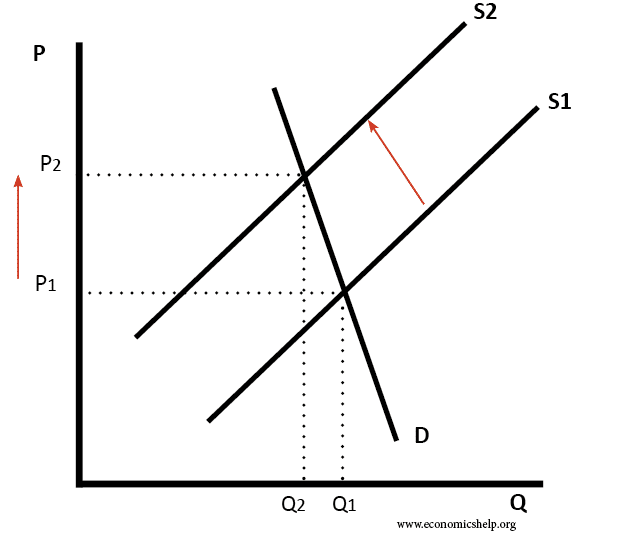Supply refers to the quantity of a good that the producer plans to sell in the market. Supply will be determined by factors such as price, the number of suppliers, the state of technology, government subsidies, weather conditions and the availability of workers to produce the good.
Movement along the supply curve
- As price increases firms have an incentive to supply more because they get extra revenue (income) from selling the goods.
- If price changes, there is a movement along the supply curve, e.g. a higher price causes a higher amount to be supplied.

An increase in the price from 80 to 116 causes an increase in quantity supplied from 60 to 70.
Shifts in the Supply curve

This occurs when firms supply more goods – even at the same price. For example, a new machine which enables more of the good to be produced for the same cost.
Factors affecting the supply curve
- A decrease in costs of production. This means business can supply more at each price. Lower costs could be due to lower wages, lower raw material costs
- More firms. An increase in the number of producers will cause an increase in supply.
- Investment in capacity. Expansion in the capacity of existing firms, e.g. building a new factory
- The profitability of alternative products. If a farmer sees the price of biofeuls increase, he may switch to growing crops for biofuels on all his fields and this will lead to a fall in the supply of food, such as wheat.
- Related supply. If there is an increase in the supply of beef (from cows) then there will also be an increase in the supply of leather.
- Weather. Climatic conditions are very important for agricultural products
- Productivity of workers. If workers become more motivated and work hard, then there will be a significant increase in output and supply.
- Technological improvements. Improvements in technology, e.g. computers or automation, reducing firms costs.
- Lower taxes. Lower direct taxes (e.g. tobacco tax, VAT) reduce the cost of goods.
- Government subsidies. Increase in government subsidies will also reduce the cost of goods, e.g. train subsidies reduce the price of train tickets.
- Objectives of firms. If firms are profit maximisers and collude with other firms, we may see a fall in supply as they try to maximise profits. However, if they switch to targetting sales or revenue maximisation, then we will see an increase in supply.
Shift in supply to the left

In this case, there is a fall in supply. The supply curve shifts to the left. This causes a higher price. The supply can shift to the left because
- Fewer firms in the market
- Bad weather (agriculture)
- Higher taxes
- Decline in productivity (workers work less hard.)
Factors that cause a shift in supply to the right

- More firms entering the market
- Improved technology, reducing the cost of production
- Increased size of output leading to economies of scale and effective mass production.
- Lower tax rates
- Higher government subsidies
Definition: joint supply
Joint supply occurs when two goods are supplied together. E.g. If you produce beef you will get leather as a side effect.
Factors affecting the supply of labour
- The supply of labour is quite similar to the supply of goods. The supply of labour will depend upon factors such as
- Quantity of skilled labour. The supply of highly qualified jobs like lawyers is fairly limited because of the qualifications required.
- The desirability of the job. If a job is concerned enjoyable, more people may wish to do it.
- The quantity of immigration. An unattractive job like fruit picking may depend on seasonal workers from abroad. If immigration is cut, this supply of seasonal labour may fall.
- Demographic factors. An ageing population and a falling birth rate will lead to a decline in the working-age population.
Supply side shocks and inflation
A supply-side shock is when an economy faces shortages of a good in several markets. For example, if OPEC restricts the supply of oil, this will cause rising oil prices and a consequent rise in the cost of transport. Higher oil prices typically cause the supply of many goods to become more expensive and this can feed through into higher prices and inflation.
Further reading
